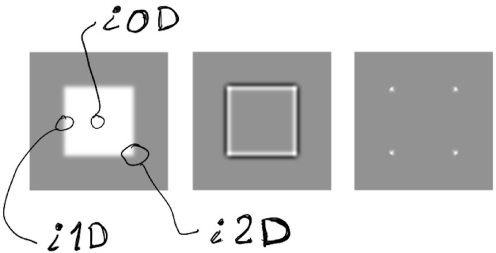References
1BalléJ.LaparraV.SimoncelliE. P.End-to-end optimized image compression5th Int’l. Conf. on Learning Representations, ICLR 20172017OpenReview.netAmherst, MA10.48550/arXiv.1611.01704
2BarlowH.1961Possible principles underlying the transformation of sensory messagesSensory Communication1217234217–34
3BarthE.CaelliT.ZetzscheC.1993Image encoding, labelling and reconstruction from differential geometryCVGIP: Graph. Models Image Process.55428446428–4610.1006/cgip.1993.1033
4BarthE.FerraroM.ZetscheC.ArcelliC.CordellaL. P.di BajaG. S.2001Global topological properties of images derived from local curvature featuresVisual Form 2001. Lecture Notes in Computer Science285294285–94SpringerCham10.1007/3-540-45129-3_25
5BarthE.WatsonA. B.2000A geometric framework for nonlinear visual codingOpt. Express7155185155–8510.1364/OE.7.000155
6BarthE.ZetzscheC.1998Endstopped operators based on iterated nonlinear center-surround inhibitionProc. SPIE3299677867–78
7BarthE.ZetzscheC.KriegerG.1998Curvature measures in visual information processingOpen Syst. Inf. Dyn.5253925–3910.1023/A:1009675801435
8BengioY.2009Learning deep architectures for AIFound. Trends Mach. Learn.211271–12710.1561/2200000006
9BurgM. F.CadenaS. A.DenfieldG. H.WalkerE. Y.ToliasA. S.BethgeM.EckerA. S.2021Learning divisive normalization in primary visual cortexPLOS Comput. Biol.17e100902810.1371/journal.pcbi.1009028
10CirincioneA.VerrierR.BicA.OlaiyaS.DiCarloJ. J.UdeigweL.MarquesT.2022Implementing divisive normalization in CNNs improves robustness to common image corruptionsSVRHM 2022 Workshop @ NeurIPSOpenReview.netAmherst, MA
11DapelloJ.MarquesT.SchrimpfM.GeigerF.CoxD.DiCarloJ. J.2020Simulating a primary visual cortex at the front of cnns improves robustness to image perturbationsAdvances in Neural Inf. Process. Systems3313 07313 08713 073–87
12Do CarmoM. P.Riemannian Geometry1992BirkhäuserBoston
13DorrM.VigE.BarthE.2013Efficient image representations and featuresProc. SPIE865186510R10.1117/12.2002300
14FieldD. J.OlshausenB. A.BradyN.1996Wavelets, blur, and the sources of variability in the amplitude spectra of natural scenesProc. SPIE2657108119108–19
15FukushimaK.1980Neocognitron: a self organizing neural network model for a mechanism of pattern recognition unaffected by shift in positionBiol. Cybern.36193202193–20210.1007/BF00344251
16GrüningP.
17GrüningP.BarthE.2021Bio-inspired min-nets improve the performance and robustness of deep networksSVRHM 2021 Workshop@ NeurIPSOpenReview.netAmherst, MA
18GrüningP.BarthE.2021FP-nets for blind image quality assessmentJ. Percept. Imag.4010402-1010402-13010402-1–010402-1310.2352/J.Percept.Imaging.2021.4.1.010402
19GrüningP.MartinetzT.BarthE.
20GrüningP.MartinetzT.BarthE.2020Log-nets: Logarithmic feature-product layers yield more compact networksArtificial Neural Networks and Machine Learning – ICANN 2020799179–91SpringerCham10.1007/978-3-030-61616-8_7
21GrüningP.MartinetzT.BarthE.2022FP-nets as novel deep networks inspired by visionJ. Vis.22888–10.1167/jov.22.1.8
22HanD.KimJ.KimJ.2017Deep pyramidal residual networksProc. IEEE Conf. on Computer Vision and Pattern Recognition592759355927–35IEEEPiscataway, NJ10.1109/CVPR.2017.668
23HeK.ZhangX.RenS.SunJ.2016Deep residual learning for image recognitionProc. IEEE Conf. on Computer Vision and Pattern Recognition770778770–8IEEEPiscataway, NJ10.1109/CVPR.2016.90
24HuangG.LiuZ.Van Der MaatenL.WeinbergerK. Q.2017Densely connected convolutional networks2017 IEEE Conf. on Computer Vision and Pattern Recognition (CVPR)226122692261–9IEEEPiscataway, NJ10.1109/CVPR.2017.243
25IoffeS.SzegedyC.2015Batch normalization: Accelerating deep network training by reducing internal covariate shiftICML’15: Proc. 32nd Int’l. Conf. on Machine LearningVol. 37448456448–56PMLRCambridge, MA
26KriegerG.ZetzscheC.BarthE.1995Nonlinear image operators for the detection of local intrinsic dimensionalityProc. IEEE Workshop Nonlinear Signal and Image Processing182185182–5IEEEPiscataway, NJ
27KrizhevskyA.NairV.HintonG.
28KrizhevskyA.SutskeverI.HintonG. E.PereiraF.BurgesC.BottouL.WeinbergerK.2012Imagenet classification with deep convolutional neural networksAdvances in Neural Information Processing SystemsVol. 25Curran AssociatesRed Hook, NY
29LabuschK.SiewertU.MartinetzT.BarthE.2007Learning optimal features for visual pattern recognitionProc. SPIE649264920B10.1117/12.713371
30LeCunY.BoserB.DenkerJ. S.HendersonD.HowardR. E.HubbardW.JackelL. D.1989Backpropagation applied to handwritten zip code recognitionNeural Comput.1541551541–5110.1162/neco.1989.1.4.541
31LuoT.MouX.2010Divisive normalization in channelized hotelling observerProc. SPIE752775271K10.1117/12.845078
32LyuS.SimoncelliE.2009Nonlinear extraction of independent components of natural images using radial gaussianizationNeural Comput.21148515191485–51910.1162/neco.2009.04-08-773
33LyuS.SimoncelliE. P.2007Statistically and perceptually motivated nonlinear image representationProc. SPIE649264920710.1117/12.720848
34MotaC.BarthE.BaratoffG.NeumannH.2000On the uniqueness of curvature featuresDynamische PerzeptionProc. in Artificial IntelligenceVol. 9175178175–8Infix VerlagKöln
35OlshausenB. A.CadieuC.CulpepperJ.WarlandD. K.2007Bilinear models of natural imagesProc. SPIE649264920610.1117/12.715515
36OlshausenB. A.FieldD. J.1996Emergence of simple-cell receptive field properties by learning a sparse code for natural imagesNature381607609607–910.1038/381607a0
37OlshausenB. A.FieldD. J.1996Learning efficient linear codes for natural images: the roles of sparseness, overcompleteness, and statistical independenceProc. SPIE2657132138132–810.1117/12.238708
38PaitonD. M.FryeC. G.LundquistS. Y.BowenJ. D.ZarconeR.OlshausenB. A.2020Selectivity and robustness of sparse coding networksJ. Vis.20101010–10.1167/jov.20.12.10
39PanX.KartalE.GiraldoL. G. S.SchwartzO.Brain-inspired weighted normalization for CNN image classificationInt’l. Conf. on Learning Representations (ICLR)2021
40RanjanR.PatelV. M.ChellappaR.2017Hyperface: A deep multi-task learning framework for face detection, landmark localization, pose estimation, and gender recognitionIEEE Trans. Pattern Anal. Mach. Intell.41121135121–3510.1109/TPAMI.2017.2781233
41RenM.LiaoR.UrtasunR.SinzF. H.ZemelR. S.Normalizing the normalizers: Comparing and extending network normalization schemes5th Int’l. Conf. on Learning Representations, ICLR 20172017
42SandlerM.HowardA.ZhuM.ZhmoginovA.ChenL.-C.2018Mobilenetv2: Inverted residuals and linear bottlenecksProc. IEEE Conf. on Computer Vision and Pattern Recognition451045204510–20IEEEPiscataway, NJ10.1109/CVPR.2018.00474
43SinzF. H.PitkowX.ReimerJ.BethgeM.ToliasA. S.2019Engineering a less artificial intelligenceNeuron103967979967–7910.1016/j.neuron.2019.08.034
44StarckJ.-L.FadiliJ.EladM.NowakR.TsakalidesP.2011Introduction to the issue on adaptive sparse representation of data and applications in signal and image processingIEEE J. Sel. Top. Signal Process.5893895893–510.1109/JSTSP.2011.2162154
45SunX.NasrabadiN. M.TranT. D.2020Supervised deep sparse coding networks for image classificationIEEE Trans. Image Process.29405418405–1810.1109/TIP.2019.2928121
46TanC.SunF.KongT.ZhangW.YangC.LiuC.2018A survey on deep transfer learningInt’l. Conf. on Artificial Neural Networks270279270–9SpringerCham10.1007/978-3-030-01424-7_27
47ValerioR.NavarroR.2003Nonlinear image representation with statistical independent features: efficient implementation and applicationsProc. SPIE5007352363352–63
48VeitA.WilberM. J.BelongieS.2016Residual networks behave like ensembles of relatively shallow networksAdv. Neural Inf. Process. Syst.29
49VigE.DorrM.CoxD.2012Space-variant descriptor sampling for action recognition based on saliency and eye movementsLNCS 7578, Proc. European Conf. on Computer Vision849784–97SpringerCham10.1007/978-3-642-33786-4_7
50VigE.DorrM.MartinetzT.BarthE.2012Intrinsic dimensionality predicts the saliency of natural dynamic scenesIEEE Trans. Pattern Anal. Mach. Intell.34108010911080–9110.1109/TPAMI.2011.198
51WatanabeS.Pattern Recognition: Human and Mechanical1985Wiley-InterscienceHoboken, NJ
52WiskottL.SejnowskiT. J.2002Slow feature analysis: Unsupervised learning of invariancesNeural Comput.14715770715–7010.1162/089976602317318938
53ZbontarJ.JingL.MisraI.LeCunY.DenyS.
54ZeilerM. D.FergusR.2014Visualizing and understanding convolutional networksEuropean Conf. on Computer Vision818833818–33SpringerCham10.1007/978-3-319-10590-1_53
55ZetzscheC.BarthE.1990Fundamental limits of linear filters in the visual processing of two-dimensional signalsVis. Res.30111111171111–710.1016/0042-6989(90)90120-A
56ZetzscheC.BarthE.1990Image surface predicates and the neural encoding of two-dimensional signal variationProc. SPIE1249160177160–7710.1117/12.19667
57ZetzscheC.BarthE.1991Direct detection of flow discontinuities by 3D curvature operatorsPattern Recognit. Lett.12771779771–910.1016/0167-8655(91)90075-W
58ZetzscheC.BarthE.WegmannB.WatsonA. B.1993The importance of intrinsically two-dimensional image features in biological vision and picture codingDigital Images and Human Vision109138109–38MIT PressCambridge, MA
59ZetzscheC.KriegerG.1999Nonlinear neurons and higher-order statistics: new approaches to human vision and digital image processingProc. SPIE364410.1117/12.348430
60ZetzscheC.NudingU.2007Nonlinear encoding in multilayer LNL systems optimized for the representation of natural imagesProc. SPIE649264920410.1117/12.710650
61ZetzscheC.RöhrbeinF.2001Nonlinear and extra-classical receptive field properties and the statistics of natural scenesNetw.: Comput. Neural Syst.1233110.1080/net.12.3.331.350

 Find this author on Google Scholar
Find this author on Google Scholar Find this author on PubMed
Find this author on PubMed